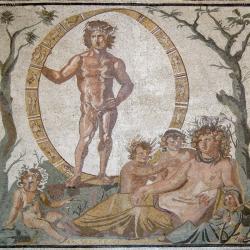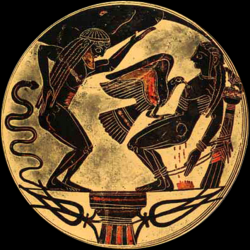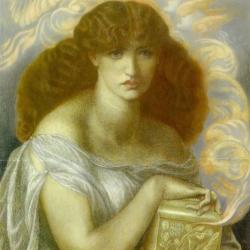You are here
Week 3
The theme for this week’s stories is Creation and the history topic is Greek athletics and the Olympic Games. There are two lead stories, Creation 1 and Creation 3, which tell of the creation of the world, the victory of the gods and the first woman. In Creation 2, the Titan Prometheus makes the first mortal humans and is punished for disobeying Zeus.
History materials
- Main topic
- Key ideas
- Making the link
- Teaching the topic
Greek athletics: the Olympic Games
The festival of the Olympic Games took place every four years in honour of Zeus at his sanctuary at Olympia in southern Greece. They are not associated with Mt Olympos. Traditionally, the first Games took place in 776BC and they ran uninterrupted until AD393 when they were abolished by the Christian Roman emperor Theodosius I because they were regarded as part of a pagan cult. They were the largest and most famous of the so-called ‘panhellenic’ festivals, festivals open to anyone who was Greek, in contrast to local festivals which might be restricted to citizens of the city-state whose festival it was. It was expected, though not always actually the case, that all wars would be suspended to allow athletes to travel to Olympia in peace. Although a winning athlete might benefit from gifts from his city-state, the official prize at Olympia was a wreath of olive leaves. This spirit of friendly competition between states and of the amateur athlete became Olympic ideals in the re-invention of the Games in the late nineteenth century and traces of them remain even today.
Pleasing the gods
Greek gods and goddesses were both supremely powerful and very human. Their human characteristics meant they could be pleased or offended and they used their power accordingly. Important aspects of the Greeks’ relationship with the gods were the avoidance of disrespect and the securing of their favour by giving them things they liked, for example, gifts, festivals and, in particular, animal sacrifice.
Winning honour
Although athletes could win very valuable prizes at other professional competitions, an Olympic victory brought the greatest prestige to them personally and to the city-state from which they came. Home city-states usually rewarded victorious athletes and gained status through their success. The sanctuary at Olympia was full of statues and buildings set up by Greek city-states as a form of rivalry to be foremost in honouring the gods. Religion and sport were spheres for the practice of political competition between cities.
The most obvious link between the story and the main topic is the emergence of Zeus as king of the gods and his role as the focus of the Olympic festival. It would be worth enriching the link by spending a little time on the idea of sacrifice as a way of pleasing the gods, which then leads directly to the festival at Olympia.
Zeus and Prometheus
A good way to start would be to identify all the things that Prometheus does in the story that provoke the anger of Zeus and discuss how these benefited humans, but also set them at a disadvantage. Bring out the huge imbalance between the power of Zeus and the weakness of humans.
Look at the figurine of Zeus throwing his thunderbolt and discuss how it shows his strength and power. Compare it with the statue of Olympian Zeus. What are the different ways in which the two statues communicate Zeus’ power? How might people react differently to the two statues?
Small figures of Zeus throwing his thunderbolt were often dedicated as gifts in his sanctuaries. They show his vigorous strength.
This Roman statue is based on the great statue of Zeus in his temple at Olympia. It shows him as a king, seated on his throne. It communicates his power and invites respect through the size, the facial expression and the dignity of his pose.
Now look at the painting of Prometheus and identify the weakness and helplessness of the human figure. Bring out the contrast between gods and humans as this will be important for understanding the unequal relationship between gods and humans in Greek belief and how this was negotiated by humans.
An early 20th century painting of Prometheus. It shows a slightly different version of the story where he has just made a human being and waits for it to be given life by a nymph. The size of Prometheus can be appreciated in contrast to the helplessness of the human.
A key question to ask is whether the children can think of any ways in which humans might have been able to soften Zeus’s anger — you might remind the children that Prometheus made humans in the image of gods and Titans, so they would have similar feelings and wishes. This should lead them to the idea that humans might do things to please Zeus and from there you can move to what these might be.
Fire and sacrifice
The Greek sacrifices information sheet provides a useful summary of different types of sacrifice. It includes three pictures which you could use to identify the stages and details of an animal sacrifice. Central to animal sacrifice was the use of fire to burn part of the animal so that the gods could enjoy it through its smoke. You could discuss how the humans used the fire that Prometheus stole to provide enjoyment for the gods. Another story about Prometheus describes how he invented sacrifice. Of course, the fire also allowed the worshippers to have a great feast after the ceremony. All major religious festivals involved sacrifices and feasting.
Greek sacrifices information sheet
An information sheet for children with details of different sorts of offerings and sacrifice and three drawings of an animal sacrifice.
You might like to work through the online resource Story of a sacrifice (see below) on the interactive whiteboard. You could compare the two Pot paintings of a sacrifice: look at the first one and identify the details; then look at the second — what more do the children learn from the second painting?
An interactive exploration of a pot painting showing all the different elements of a sacrifice. Children can click through the details and the stages.
Pot painting of a sacrifice 1
Pot painting of a sacrifice 2
These two scenes from pots show many details of a sacrifice: the altar, fire on the altar, wine being poured from a cup as an offering, long skewers with meat ready to be grilled, participants wearing wreaths, an aulos player.
There is a straightforward relationship between the need to keep the gods happy and their worship through sacrifices, sanctuaries and festivals. You could refer back to the role of theatre festivals in the worship of Dionysos in the materials for Week 2 and to the Greek festivals information sheet provided there.
The Olympic festival
The Olympic festival sheet gives an overview of the events and context of the festival, some of which you can then follow up in detail. You can compare this festival with what the children learned about theatre festivals. Try asking them why they think the Greeks thought that things like theatre, sport and competitions in general were suitable ways of honouring the gods.
An information sheet for children with details of the participants and spectators and a provisional timetable of the events. There is disagreement among historians as to the exact order of events and how it changed through the history of the Games, but this timetable is reasonably likely for the mid-fifth century BC.
Contrast the ancient Olympic festival with the modern Games in that the modern Games change location each time they are put on whereas the ancient festival always remained at Olympia, which was not itself a population centre. The ancient festival was tied closely to Zeus and Olympia was associated with him so there were religious reasons for it staying in one place. This is not to say that the nearest city to Olympia, Elis, did not gain prestige from its role in organising the festival. It has been suggested that the modern Olympics should stay in one place — what do the children think of that idea?
Use the Ancient Olympia image sheet and the weblink to a Plan of Olympia to explore the different buildings on the site and their functions — see below. Draw children’s attention to the fact that the cities’ treasure houses, where they left gifts for Zeus, and the many statues of victorious athletes provided opportunities for showing off. You might discuss whether the modern Games are just an opportunity for countries to try to prove they are better than others.
A simplified line drawing of the site at Olympia showing what the main buildings looked like. The hippodrome, where the horse and chariot racing took place was off the plan to the lower right.
A plan of the site at Olympia labelled in English showing the site as it is today.
Once the children are familiar with the site of Olympia, they might work through the online interactive The games at Olympia on the whiteboard or on individual computers. They will be able to see the events of each day and whereabouts in the sanctuary they took place. A variety of writing opportunities might arise from this resource.
An interactive programme of the events of the festival with the areas of the site highlighted where different activities took place.
This weblink provides lots of very good photos of how Olympia looks today. The photos cannot be downloaded or copied. The photos of the starting line and the water channels are particularly useful.
Greek athletics
Greek athletics activities bank
This excellent weblink provides accessible information for teachers about Greek athletics, images and resources, weblinks and ideas for teaching activities.
When the children are familiar with the various events, you could test their knowledge using the Athletic events pot painting. Ask them to identify the different events they can see, noting the presence of the aulos players to accompany the athletes, and of the trainers and judges who make sure everything is done fairly.
A mixing bowl for wine with figure panels on the neck. The image can be zoomed very close. The lower panel shows different athletics activities: (left to right) an aulos player, two athletes getting ready for the race in armour and their trainer, a runner, a discus thrower, an aulos player, a javelin thrower, two wrestlers, a trainer/judge with a stick, two boxers or all-in fighters bleeding from wounds and the right hand one holding up his finger to show defeat, a trainer and a boxer waiting his turn.
The ideal of fair play in sport is almost always in the public eye, whether in the issue of drug abuse or in the feigning of fouls and injuries. You could start a discussion of this by looking at a clear example of cheating in the Two fights pot painting where one of the competitors is about to be struck by a judge. You might remind the children that on the first day of the festival all athletes went to the Council Building to swear an oath to obey the rules of the festival. You might consider why anyone should care about cheating or in what aspects of life the children think it is most important not to cheat.
This wine cup shows two boxers on the left, their hands bound with strips of leather. They are of different builds and the one on the right may have a boxer’s nose and scars on his face. The two fighters on the right are taking part in the sport called ‘pankration’, all-in fighting, a combination of boxing and wrestling, in which the only prohibited actions were gouging eyes and biting. The athlete on the right is gouging and perhaps also biting and a trainer wades in with his stick.
You could use the figure of A woman athlete to remind the children that competitors in the Olympic athletic games, and all the others, had to be men. Only unmarried women and the priestess of Demeter were allowed to watch the events. There was an athletics festival for women at Olympia to honour the goddess Hera. It consisted of one race and took place every four years between the Olympics. Spartan women exercised regularly in order to produce healthy children. It was not until the 2012 Olympic Games in London that all events became matched between women and men.
This small bronze figure, probably from Sparta, shows a young woman running. She hitches up her skirt to free her legs. It is not known for sure whether this represents a woman athlete and she may just be running away from a danger of some sort.
The prize for the winner at Olympia was a wreath of olive leaves from the sacred tree of Zeus and there was only one winner in each event, no second or third. You could ask the children what they think of that idea. You could look at the marble carving of Athletic prizes and discuss each one with the children — they may even be able to use the alphabet to work out some of the words. Explore what the carving tells them about the athlete — bear in mind that he must have been famous and/or rich for him to have such a fine memorial. Draw their attention to the fact that it is broken; if we had the rest of the carving what else do they think it might tell us?
This carved marble dedication from around AD100/200 commemorates an athlete’s victories at four games. The prizes shown are: a jar of fine olive oil from the Panathenaic festival at Athens (for Athena), a shield from the Aspis festival at Argos (for Hera), a wreath of pine from the Isthmian games (for Poseidon near Corinth) and a wreath of wild celery from the Nemean games (for Zeus). The inscription is broken and we cannot see his name, but it tells us that he came from the town of Rhamnous in the territory of Athens.
Continuing theme: gods and goddesses
Several new gods and goddesses appear in this week’s stories and can be added to the class list along with initial comments on what the children learn about them from the stories. The list now includes all the major gods. They are often referred to as Olympian gods, as they were thought to live on Mt Olympos, in contrast with the lesser deities of nature such as woods, rivers, mountains, winds.
By the end of this week, if you have studied all three stories, the children will have encountered the following additional gods and divine beings:
Zeus — appeared briefly in Week 1: Phaethon
Poseidon — with Hades mentioned as brothers of Zeus in Creation 1
Hades — appeared briefly in Week 1: Phaethon
Hestia — with Demeter and Hera mentioned as sisters of Zeus in Creation 1
Demeter
Hera
The Fates — more ancient than the gods
Hephaistos
Hermes
Athena — her voice and those of Aphrodite and Ares are heard by Pandora in Creation 3
Aphrodite
Ares
Feel free to include the Titans, Ouranos and Gaia if the class have engaged well with them. Prometheus certainly figures in western art and literature and the term ‘titanic’ is not uncommon.


